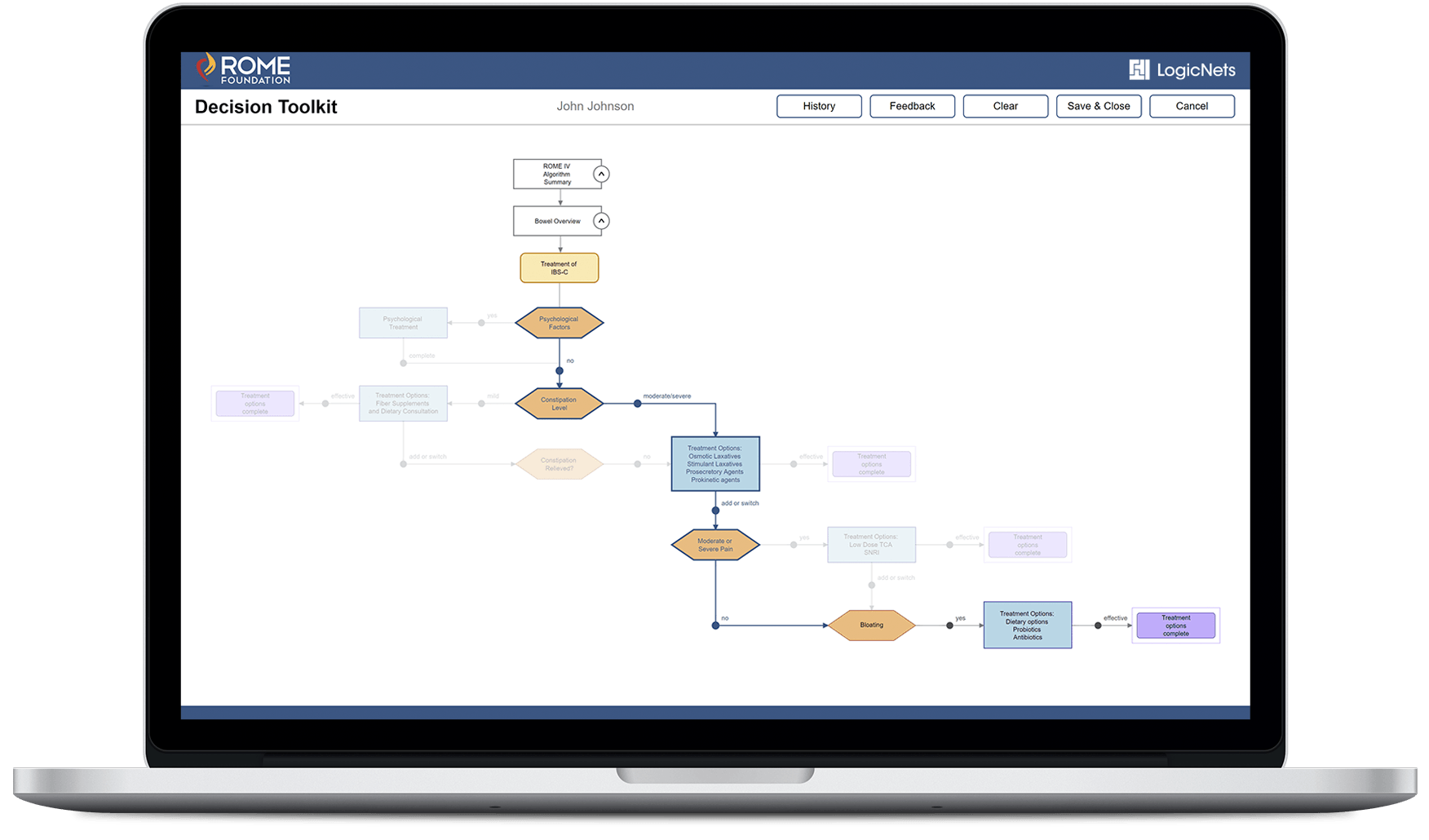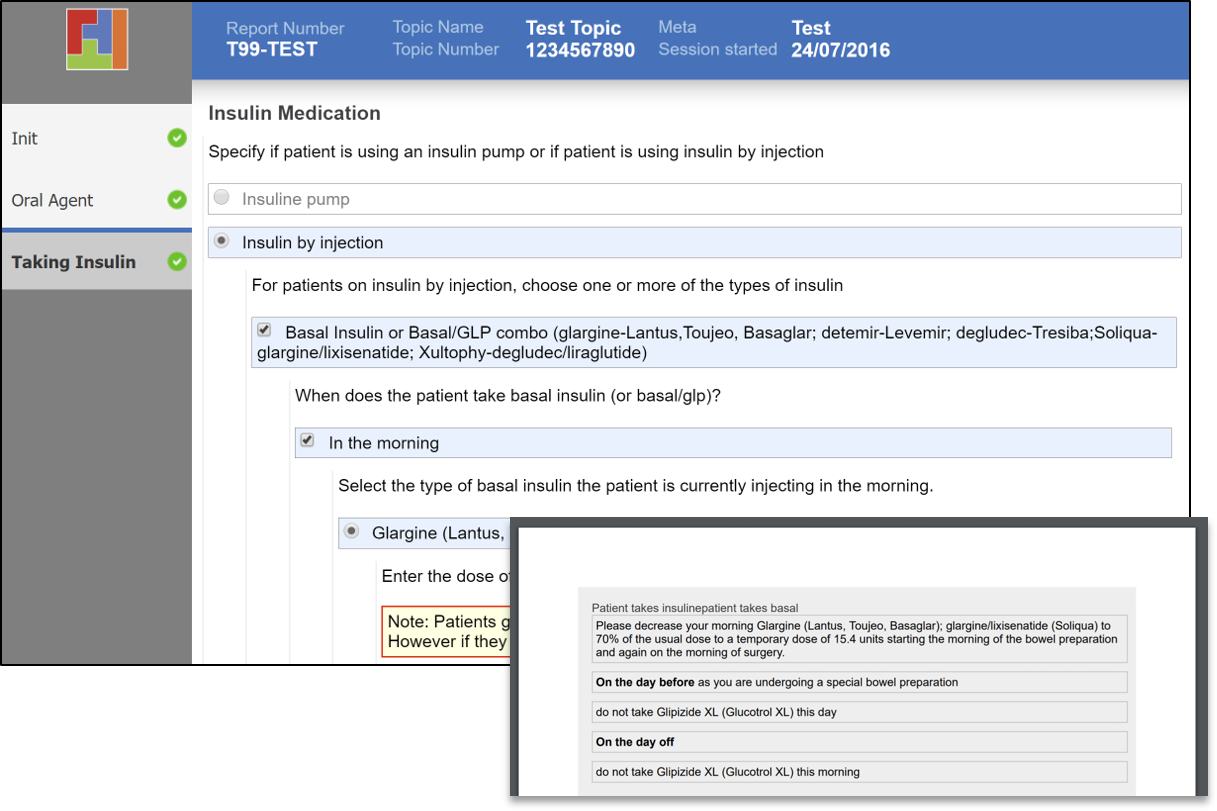Clinical Decision Support
Delivering on the CDS Promise
Clinical decision support (CDS) has long offered great promise for improving healthcare delivery by giving practitioners on-demand, easy-to-consume access to diagnostic/treatment and managed care protocols from within the workflow. Unfortunately, for a range of reasons extending from the lack of flexibility to address edge cases and localized requirements to the inability to dynamically and intelligently access the patient record, CDS services have often failed to fulfill their promise.
LogicNets is a next-generation approach to CDS. First, our system is not defined by or limited to any one body of medical knowledge. Rather, it is a platform that medical knowledge organizations, professional societies, and providers from all medical fields can work in, without programming, to directly capture and deliver their special areas of evidence and consensus-backed knowledge as a vital on-demand resource within the workflow.
Our visual rendering of decision pathways makes LogicNets a natural platform for interactive diagnostic and treatment guidelines. Clinicians trust our graphical presentation because it allows them to quickly see and review all scenarios without laborious data entry or processing of dense reference material. Furthermore, LogicNets is flexible enough to constantly adjust for edge cases and special local and regional factors.
In practice, LogicNets CDS applications are unobtrusive and usually just reinforce clinical decisions. But they will also painlessly highlight when you have missed a vital factor or were unaware of changing practices. This flexibility is why some of the most advanced and promising interactive medical guidance products are written and delivered on our system.
Share best practices
Clinicians can perform like experts outside their area of specialty when they have clear visibility to the algorithms -- and supporting evidence and information -- used and developed by leading practitioners.
Reduce cost
When clinicians have on-demand and efficient guidance, they can consistently shorten the process, eliminate mistakes, and reduce liability…all greatly reducing the cost of care and increasing patient satisfaction.
Improve outcomes
In study after study, clinical decision support is shown to improve outcomes. And it stands to reason, as most clinicians will accept CDS recommendations when they are unsure of a decision or if mistakes have been identified.
Increase quality
The ability to structure any of your best practices into on-demand, guided applications lets you control and improve activities in any of the domains you monitor for quality including: patient safety, effectiveness, patient centeredness, timeliness, efficiency, and more.

Unique CDS Features
LogicNets unique visual approach for capturing and delivering decision processes, together with powerful data handling and integration, make it an unmatched option for rapidly implementing on-demand guidance that medical professionals will want to rely on. Important features include:
Visual Guideline Navigation – LogicNets offers a unique visual pathway representation of clinical decision processes. Not only can experts capture content visually, but users of the application can interactively navigate through diagnostic and treatment protocols as the system highlights pertinent pathways and subdues the inappropriate ones.
Patient data and workflow integration – Our CDS applications integrate with the EPR so that clinicians are navigated to guidance based on known patient conditions and history. If patient data is incomplete, the clinician provides input to reach a recommendation. Either way, clinicians don’t waste time with redundant data entry.
Informatics – LogicNets’ informatics handling layer enables efficient and flexible mapping and validation of EMR coding systems to the CDS protocol data model so that guidance from external sources can easily integrate with the workflow.
Triggering – LogicNets CDS protocols support workflow triggering so that clinicians viewing a patient record can automatically determine the guidance protocols that are available and appropriate to the particular patient.
Integrated Text and Visual Navigation – You can navigate CDS pathways in LogicNets both by interacting directly with the graphical decision tree image and by answering text forms. Selecting a value from a radio list item automatically navigates the visual pathway to the next node. Clicking on a pathway label automatically fills in the corresponding form.
Pathway Extensions – LogicNets makes complex pathways easy to interact with by allowing them to be broken up into multiple levels. As you select a particular pathway option, the pathway extends into the next level and repositions you for follow-on questions.


Advice, Calculators, Orders – LogicNets provides pathway node types that correspond neatly with standard medical practices. Answering questions and routing on a particular pathway can lead to nodes that present advice clearly, perform complex calculations (such as scores), or present ordering options.
Linked References – At any step in a CDS pathway, LogicNets can make a wide range of useful contextually relevant information available. This includes source references for evidence, educational aids, sample images, etc. The content itself can be stored in the LogicNets knowledge repository or be linked to from external repositories or online resources.
Reporting and analysis – LogicNets’ approach of using pathways for representing clinical processes delivers major benefits with regard to reporting and analysis. Each guidance session records not only the results, but the exact pathway and data inputs used to reach them. LogicNets saves and structures this robust session data to support a wide range of reporting and analytics so that you can understand how CDS content is being used, quantify benefits and provide a feedback loop for continuous CDS content improvement.
Create Your CDS Applications
Interactive Diagnostics & Treatment Protocols
Provide users with on-demand evidence-based guidance for navigating structured diagnostic and treatment algorithms.
Guided Care Pathway Management
Direct a wide range of clinical process among a group of clinical players and clearly demonstrate to patients.
Appropriate Use Validation
Protocols for determining appropriate use in virtually any clinical area can be integrated seamlessly into the ordering and assessment workflow, providing accountability and audit-ability.
What Our Customers Say



